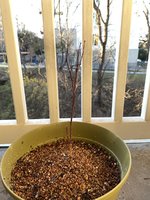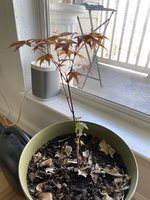southernleaf
Seedling
I purchased this young cutting online as a new project. This will be my second maple and I am definitely still a bonsai rookie. I’ve posted a pic of the tree as well as the planter I intend on using for the next couple of years. Reason for my post is that I want to make sure I do this very well from the beginning, avoiding easy mistakes and setting the tree up for the most success long-term. Here is my plan. Any thoughts/critique/advice would be much appreciated.
1. Thick layer of sphagnum moss at the bottom of the planter to hold water/nutrients
2. Above that, a 50/50 mix of two bonsai soil blends from TinyRoots - the deciduous blend and the organic bonsai all-purpose blend.
3. Implant a flat, hard surface beneath the rootball to encourage nebari (would cardboard work or will the roots eat right through it?)
4. Wait…watch…report back!
Thanks in advance for the help.


1. Thick layer of sphagnum moss at the bottom of the planter to hold water/nutrients
2. Above that, a 50/50 mix of two bonsai soil blends from TinyRoots - the deciduous blend and the organic bonsai all-purpose blend.
3. Implant a flat, hard surface beneath the rootball to encourage nebari (would cardboard work or will the roots eat right through it?)
4. Wait…watch…report back!
Thanks in advance for the help.




